NVIDIA GeForce GTX 680 Review: Retaking The Performance Crown
by Ryan Smith on March 22, 2012 9:00 AM ESTPower, Temperature, & Noise
As always, we’re wrapping up our look at a new video card’s stock performance with a look at power, temperature, and noise. With new process nodes being the lifeblood of the GPU industry, each new process gives GPU manufacturers a chance to move their product along a continuum; do they take advantage of a power consumption reduction for the same performance level, a performance increase for the same power consumption, or something in between? For NVIDIA the answer is a bit of “all of the above”, as while the GK104 based GTX 680 is more a direct successor of the GF114 based GTX 560 Ti in terms of how the GPU was built, NVIDIA has increased their power consumption while at the same time decreasing their die size relative to GF114.
| GeForce GTX 680 Voltages | ||||
| Ref GTX 680 Base Load | Ref GTX 680 Boost Load | Ref GTX 680 Idle | ||
| 1.062v | 1.175v | 0.987v | ||
As we noted in our look at GPU Boost, the operating voltage of the GTX 680 depends on the quality of the GPU and the clockspeed it runs at. The higher the clockspeed, the higher the operating voltage, starting from a typical voltage of 1.062v at the base clockspeed of 1006MHz, up to 1.175v at the peak clockspeed of our sample of 1110MHz. Idle voltages are far most consistent however, with the GTX 680 always dropping to 0.987v at idle.
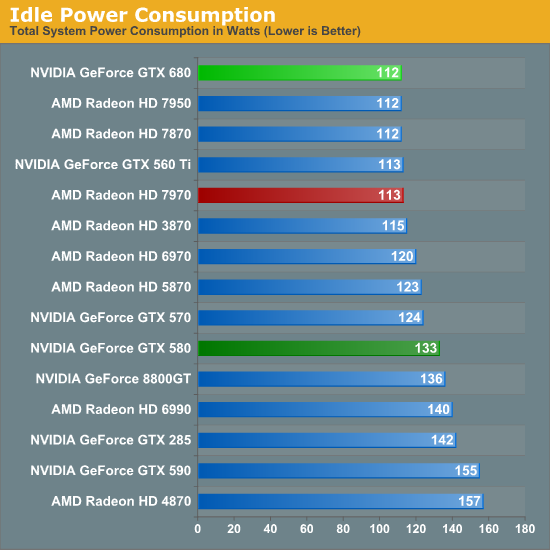
Speaking of idle, let’s start there. NVIDIA idle power consumption hasn’t significantly changed relative to GTX 560 Ti – not to say that NVIDIA hasn’t been working on this factor, but the low-hanging fruit has long been plucked. At 112W at the wall the GTX 680 is actually tied for the lowest power consumption among contemporary cards past and present, but with an estimated 15W idle TDP it’s not significantly different from any of those cards.
One interesting point though is that because GK104 is a GF114 derivative rather than a GF110 derivative, the GTX 680 does much better here compared to the GTX 580. We’re saving over 20W at the wall thanks to fewer RAM chips, less power regulation circuitry, and like most other things relating to GTX 680, a general increase in efficiency.
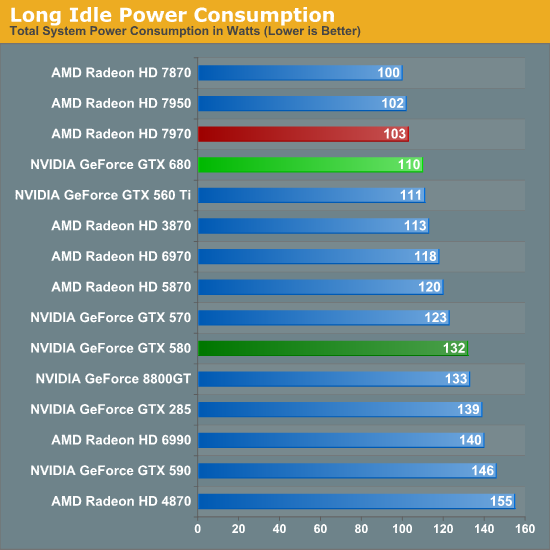
One thing NVIDIA specifically hasn’t touched though is the so-called “long idle” state where the system is powered up but the monitor is blank. GTX 680 shaves off a watt here versus GTX 560 Ti and 22W versus GTX 580, but without any special technology to further step down, they can’t match AMD and their ZeroCore Power technology.
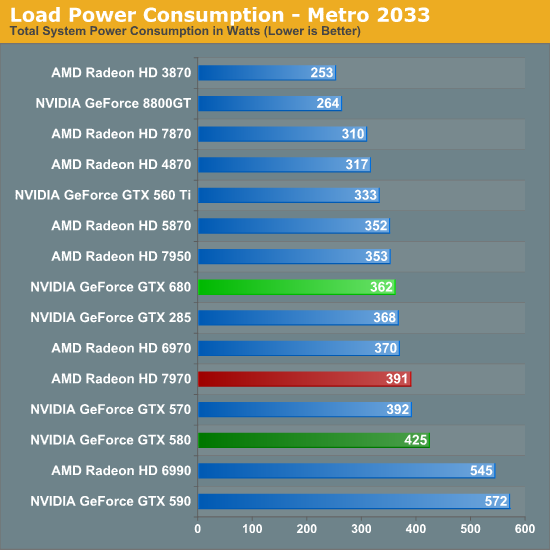
Shifting into load power consumption, our first measurement is from running our Metro 2033 benchmark. The results are roughly where we’d expect them, with the GTX 680 drawing more power than the GTX 560 Ti, but less power than the Radeon HD 7970, and compared to the GTX 580 significantly less power. Things are much closer compared to the 7950 however thanks to its similar 200W PowerTune limit, with the GTX 680 drawing only 9W more at the wall.
Because the performance of the video card here impacts the CPU load by requiring more frames to be prepared, power consumption does go up slightly with performance increases, which means some of the power consumption growth we’re seeing here relative to the GTX 560 Ti is a result of that performance gap, but measuring from the wall doesn’t let us fully separate it. NVIDIA’s power target GPU Boost on Metro 2033 is 170W, the same as the GTX 560 Ti’s TDP, but in all likelihood power consumption has jumped up at least 10W, while power consumption compared to the 7950 is probably a wash.
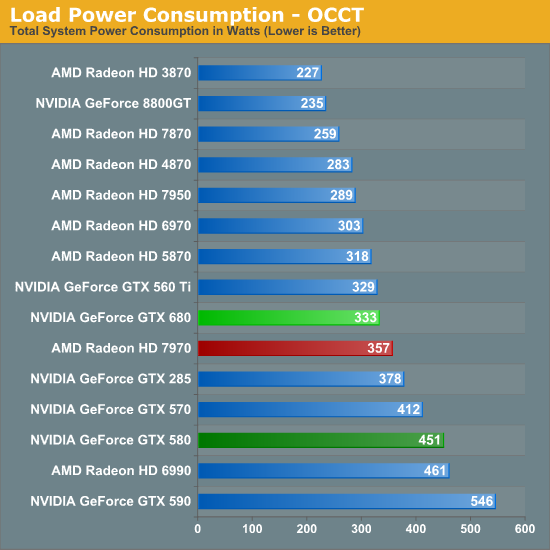
Our other power measurement is our pathological case with OCCT. In this case NVIDIA’s lack of a true throttling system continues to be to their disadvantage, as while AMD’s cards can cap their power consumption NVIDIA’s cards must keep going. In spite of this power consumption relative to the 7970 is still lower by 25W, but it blows past the 7950 by 44W. On the NVIDIA side of things though we can see just how much a smaller die and 28nm improve on matters compared to the GTX 580 – the 118W difference is nothing short of staggering. NVIDIA’s big GPUs can capture the performance crown, but they come with a high power cost, which makes taking the crown with the much smaller GK104 all the more important for NVIDIA.
On that note, it’s interesting to see that while power consumption runs high compared to AMD’s cards, compared to the GTX 560 Ti, power consumption has only ticked up by 4W. This reflects the fact that the GTX 680 is the successor to the GTX 560 Ti’s design, which means both cards have similar TDPs, though we would have actually expected the gap between the two to be wider. So in the worst case scenario NVIDA is exceeding our expectations.
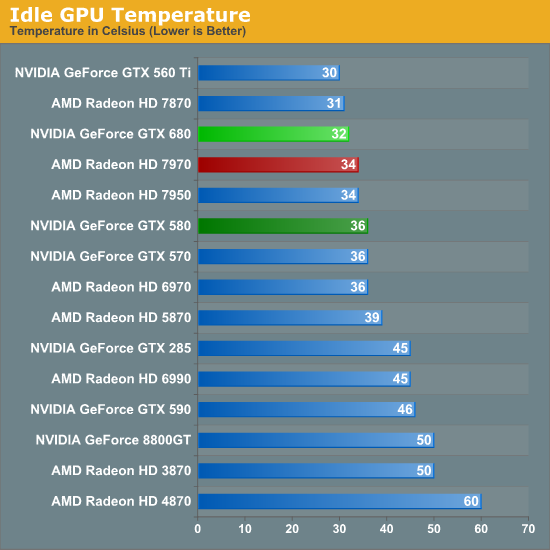
Moving past power consumption we have our look at temperatures, one of the two physical attributes that’s a derivative of power consumption. Idle temperatures aren’t too hard to do well at so long as your idle power consumption is solid and this is indeed the case for the GTX 680. The use of a blower means that NVIDIA can’t match the raw efficiency of the GTX 560 Ti, but they actually manage to edge out the Radeon HD 7900 series here. More to the point this continues what has been a long trend with regards to reducing idle temperatures; since the 8800GT the idle temperatures of NVIDIA’s top GPUs have dropped from a toasty 50C to 32C.
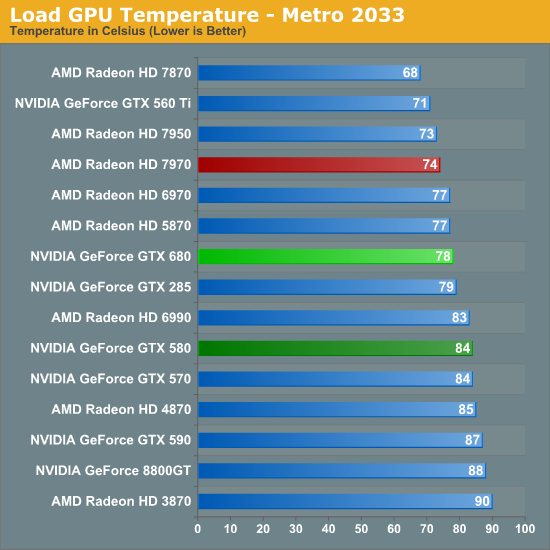
As for load temperatures, we’re once more in a familiar situation regarding NVIDIA and AMD design strategies. AMD’s aggressive cooling strategy keeps their 7900 cards in the mid-to-low 70s, while NVIDIA favors slightly higher temperatures for what we’ll see translates into less noise. At 78C under Metro NVIDIA is not repeating the common 80C+ temperatures the GTX 570 and GTX 580 reach, which is a reflection of the smaller GPU and smaller manufacturing process. NVIDIA’s max operating temperature for the GTX is 98C, so we have a good 20C to play with when it comes to overclocking.
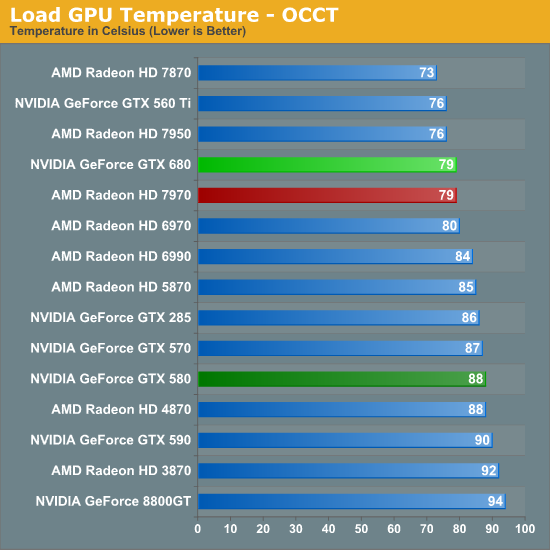
Switching over to OCCT, we suddenly find ourselves in an interesting situation when NVIDIA and AMD become relatively equalized. At 79C both the 7970 and GTX 680 are running at the same temperature, an unexpected situation given the latter’s lack of a throttling mechanism for OCCT. Once again it also drives a large gap between the GTX 680 and GTX 580, having reduced temperatures by 9C. And at the same time temperatures are up only 3C compared to the GTX 560 Ti, even with its lower power consumption and open air cooler. However if and when Big Kepler does come, I would expect GTX 580-like temperatures to return.
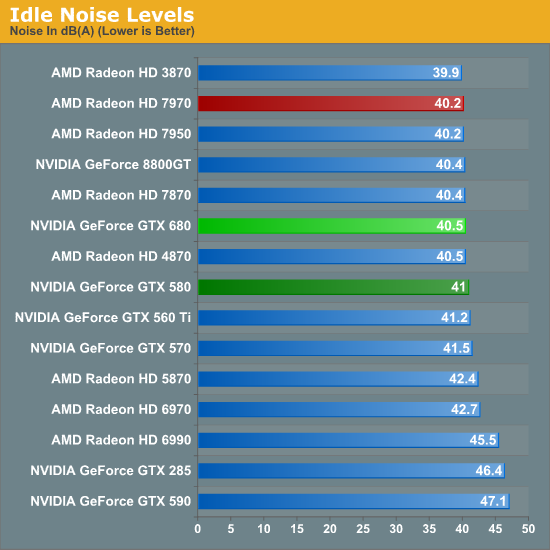
Last but not least we have our look at noise, which is typically the most important of the 3 physical attributes of a video card. Like idle temps, idle noise is largely a solved problem, which is why all of our results cluster around 40dB. The GTX 680 is 0.5dB quieter than the GTX 580 and 0.3dB louder than the 7970, but at this range the difference is nearly academic as noise from other system components is the biggest contributing factor.
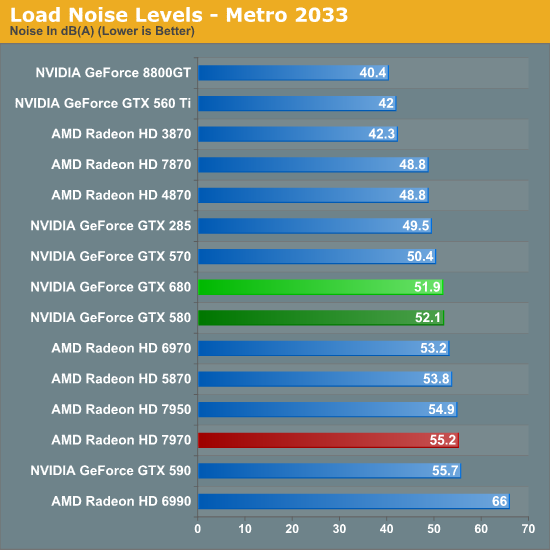
Now how does the GTX 680 fare in load noise? The answer depends on what you want to compare it to. Compared to the GTX 580, the GTX 680 is practically tied – no better and no worse – which reflects NVIDIA’s continued use of a conservative cooling strategy that favors noise over temperatures. At the same time, compared to the GTX 560 Ti this is a massive increase in noise, with just shy of a 10dB jump. The difference comes down to a few things, the most important of which is that the GTX 680 has a closed blower instead of the GTX 560 Ti’s unusually impressive open air cooler. At the same time as we’ve seen power consumption is up versus the GTX 560 Ti, so maintaining 42dB wouldn’t have been very practical even with another open air cooler.
Finally we have the Radeon comparison, where NVIDIA does quite well. AMD’s aggressive cooling strategy combined with the higher power consumption of the 7970 means that the 7970 is on the wrong side of the GTX 680 here, with the GTX 680 generating 3.3dB less noise. So while NVIDIA failed to significantly improve on the GTX 580 they did beat out AMD, which is going to be the more important difference for most buyers. All things considered I’m wondering if NVIDIA still couldn’t have done better here, but I think the limiting factor here is that NVIDIA doesn’t have a whole ventilation slot to work with.

Last, but not least, we have our look at OCCT noise. Even with a lack of throttling, the smaller range between NVIDIA’s typical and max power consumption thanks to GPU Boost – and thereby a smaller range between their typical and max heat generation – has kept both their temperatures and noise in check when moving from Metro to OCCT. NVIDIA has effectively extended their lead here, with a 4.8dB gap between the GTX 680 and the 7970, and an even larger 6.8dB gap between the GTX 680 and the GTX 580. The only real loss here is against the GTX 560 Ti, which like we saw with Metro, is simply well ahead of anything else due to its open air cooler.
Of course NVIDIA has one of the lowest power consuming video cards with a closed blower, which means they are already starting these noise tests with a favorable position. The only contemporary blower to best the GTX 580 is the 7870, and even that is only by 0.6dB.
Wrapping things up here, all things considered NVIDIA does seem to have a good job reaching balance with temperature and noise here. Their lower power consumption keeps them more than competitive with the Radeon HD 7900 series and GTX 570/580 right off the bat, and combined with their balanced cooler we’re seeing temperatures that are not too hot, and noise levels that are not too loud. There’s no doubt someone is going to try to best the reference GTX 680 in the future with a dual fan open air cooler though, so it will be interesting to see if it will be possible to improve on the GTX 680 by giving up direct cooling efficiency for lower noise levels.










404 Comments
View All Comments
Slayer68 - Saturday, March 24, 2012 - link
Being able to run 3 screens off of one card is new for Nvidia. Barely even mentioned it in your review. It would be nice to see Nvidia surround / Eyefinity compared on these new cards. Especially interested in scaling at 5760 x 1080 between a 680 and 7970.....ati666 - Saturday, March 24, 2012 - link
does the gtx680 still have the same anisotropic filtering pattern like the gtx470/480/570/580 (octagonal pattern) or is it like AMDs HD7970 all angle-independent anisotropic filtering (circular pattern)?Ryan Smith - Saturday, March 24, 2012 - link
It's not something we were planning on publishing, but it is something we checked. It's still the same octagon pattern as Fermi. It would be nice if NVIDIA did have angle-independent AF, but to be honest the difference between that and what NVIDIA does has been so minor that it's not something we've ever been able to create a noticeable issue with in the real world.Now Intel's AF on the other hand...
ati666 - Saturday, March 24, 2012 - link
thank for the reply, now i can finally make a decision to buy hd7970 or gtx680..CeriseCogburn - Saturday, March 24, 2012 - link
Yes I thank him too for finally coming clean and noting the angle independent amd algorithm he's been fanboy over for a long time has absolutely no real world gaming advantage whatsoever.It's a big fat zero of nothing but FUD for fanboys.
It would be nice if notional advantages actually showed up in games, and when they don't or for the life of the reviewer cannot be detected in games, that be clearly stated and the insane "advantage" declared be called what it really is, a useless talking point of deception that fools purchasers instead of enlightening them.
The biased emphasis with zero advantage is as unscientific as it gets. Worse yet, within the same area, the "perfectly round algorithm" yielded in game transition lines with the amd cards, denied by the reviewer for what, a year ? Then a race game finally convinced him, and in this 7000 series release we find another issue the "perfectly round algorithm" apparently was attached to flaw with, a "poor transition resolution" - rather crudely large instead of fine like Nvidia's which casued excessive amd shimmering in game, and we are treated to that information only now after the 7000 series "solved" the issue and brought it near or up to the GTX long time standard.
So this whole "perfectly round algorithm" has been nothing but fanboy lies for amd all along, while ignoring at least 2 large IQ issues when it was "put to use" in game. (transition shading and shimmering)
I'm certain an explanation could be given that there are other factors with differing descriptive explanation, like the fineness of textural changes as one goes toward center of the image not directly affecting roundness one way or another, used as an excuse, perhaps the self deceptive justification that allowed such misbehavior to go on for so long.
_vor_ - Saturday, March 24, 2012 - link
Will you seriously STFU already? It's hard to read this discussion with your blatant and belligerent jackassery all over it.You love NVIDIA. Great. Now STFU and stop posting.
CeriseCogburn - Saturday, March 24, 2012 - link
Great attack, did I get anything wrong at all ? I guess not.silverblue - Monday, March 26, 2012 - link
Could you provide a link to an article based on this subject, please? Not an attack; just curious.CeriseCogburn - Tuesday, March 27, 2012 - link
http://www.anandtech.com/show/5261/amd-radeon-hd-7...http://forums.anandtech.com/showpost.php?p=3152067...
" So what then is going on that made Civ V so much faster for NVIDIA? Admittedly I had to press NVIDIA for this - performance practically doubled on high-end GPUs, which is unheard of. Until they told me what exactly they did, I wasn't convinced it was real or if they had come up with a really sweet cheat. It definitely wasn't a cheat.
If you recall from our articles, I keep pointing to how we seem to be CPU limited at the time. "
(YES, SO THAT'S WHAT WE GOT, THEY'RE CHEATING IT'S FAKE WE'RE CPU LIMITED- ALL WRONG ALL LIES)
Since AMD’s latest changes are focused on reducing shimmering in motion we’ve put together a short video of the 3D Center Filter Tester running the tunnel test with the 7970, the 6970, and GTX 580. The tunnel test makes the differences between the 7970 and 6970 readily apparent, and at this point both the 7970 and GTX 580 have similarly low levels of shimmering.
with both implementing DX9 SSAA with the previous generation of GPUs, and AMD catching up to NVIDIA by implementing Enhanced Quality AA (their version of NVIDIA’s CSAA) with Cayman. Between Fermi and Cayman the only stark differences are that AMD offers their global faux-AA MLAA filter, while NVIDIA has support for true transparency and super sample anti-aliasing on DX10+ games.
(AMD FINALLY CATCHES UP IN EQAA PART, NVIDIA TRUE STANS AND SUPER SAMPLE HIGH Q STUFF, AMD CHEAT AND BLUR AND BLUR TEXT)
Thus I had expected AMD to close the gap from their end with Southern Islands by implementing DX10+ versions of Adaptive AA and SSAA, but this has not come to pass.
( AS I INTERPRETED AMD IS WAY BEHIND STILL A GAP TO CLOSE ! )
AMD has not implemented any new AA modes compared to Cayman, and as a result AAA and SSAA continue to only available in DX9 titles.
Finally, while AMD may be taking a break when it comes to anti-aliasing they’re still hard at work on tessellation
( BECAUSE THEY'RE BEHIND IN TESSELLATION TOO.)
Don't forget amd has a tessellation cheat in their 7000 series driver, so 3dmark 11 is cheated on as is unigine heaven, while Nvidia does no such thing.
---
I do have more like the race car game admission, but I think that's enough helping you doing homework .
CeriseCogburn - Tuesday, March 27, 2012 - link
So here's more mr curious .." “There’s nowhere left to go for quality beyond angle-independent filtering at the moment.”
With the launch of the 5800 series last year, I had high praise for AMD’s anisotropic filtering. AMD brought truly angle-independent filtering to gaming (and are still the only game in town), putting an end to angle-dependent deficiencies and especially AMD’s poor AF on the 4800 series. At both the 5800 series launch and the GTX 480 launch, I’ve said that I’ve been unable to find a meaningful difference or deficiency in AMD’s filtering quality, and NVIDIA was only deficienct by being not quite angle-independent. I have held – and continued to hold until last week – the opinion that there’s no practical difference between the two.
It turns out I was wrong. Whoops.
The same week as when I went down to Los Angeles for AMD’s 6800 series press event, a reader sent me a link to a couple of forum topics discussing AF quality. While I still think most of the differences are superficial, there was one shot comparing AMD and NVIDIA that caught my attention: Trackmania."
" The shot clearly shows a transition between mipmaps on the road, something filtering is supposed to resolve. In this case it’s not a superficial difference; it’s very noticeable and very annoying.
AMD appears to agree with everyone else. As it turns out their texture mapping units on the 5000 series really do have an issue with texture filtering, specifically when it comes to “noisy” textures with complex regular patterns. AMD’s texture filtering algorithm was stumbling here and not properly blending the transitions between the mipmaps of these textures, resulting in the kind of visible transitions that we saw in the above Trackmania screenshot. "
http://www.anandtech.com/show/3987/amds-radeon-687...
WE GET THIS AFTER 6000 SERIES AMD IS RELEASED, AND DENIAL UNTIL, NOW WE GET THE SAME THING ONCE 7000 SERIES IS RELEASED, AND COMPLETE DENIAL BEFORE THAT...
HERE'S THE 600 SERIES COVERUP THAT COVERS UP 5000 SERIES AFTER ADMITTING THE PROBLEM A WHOLE GENERATION LATE
" So for the 6800 series, AMD has refined their texture filtering algorithm to better handle this case. Highly regular textures are now filtered properly so that there’s no longer a visible transition between them. As was the case when AMD added angle-independent filtering we can’t test the performance impact of this since we don’t have the ability to enable/disable this new filtering algorithm, but it should be free or close to it. In any case it doesn’t compromise AMD’s existing filtering features, and goes hand-in-hand with their existing angle-independent filtering."
NOW DON'T FORGET RYAN HAS JUST ADMITTED AMD ANGLE INDEPENDENT ALGORITHM IS WORTH NOTHING IN REAL GAME- ABSOLUTELY NOTHING.